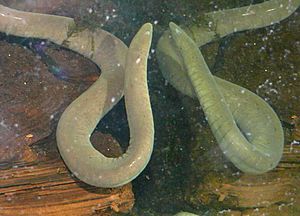Cayenne caecilian facts for kids
Quick facts for kids Cayenne caecilian |
|
|---|---|
 |
|
| Conservation status | |
| Scientific classification | |
| Genus: |
Typhlonectes
|
| Species: |
compressicauda
|
| Synonyms | |
|
Typhlonectes cunhai Cascon, Lima-Verde, and Benevides Marques, 1991 |
|
The Cayenne caecilian (Typhlonectes compressicauda) is a special type of amphibian that lives only in water. It belongs to the Typhlonectidae family. You can find this amazing creature in parts of South America, including the Amazon basin in Brazil, Peru, and Colombia. It also lives in Guyana and French Guiana, and possibly Suriname and Venezuela. These caecilians prefer to live in rivers and marshes in lowland forests.
About the Cayenne Caecilian
The Cayenne caecilian looks a bit like a long, smooth snake or a large worm. It is an amphibian that does not have any legs. Its body can be dark grey, black, or a shiny blue color.
Physical Features
This caecilian's body is flat on the sides. It has many folds across its body, which make it look like it's made of segments. A long fin runs along its back, helping it move through the water. The Cayenne caecilian can grow to be about 30 to 55 centimeters long.
Where the Cayenne Caecilian Lives
The Cayenne caecilian lives in South America. It is found in the Amazon basin and in river systems in a region called the Guianas. You can find them in areas up to 200 meters above sea level.
Conservation Status
This caecilian is quite common and lives in many places. Because of this, it is listed as "Least Concern" on the IUCN Red List of Threatened Species. This means it is not currently in danger of disappearing.
Cayenne Caecilian Life and Habits
The Cayenne caecilian lives in shallow streams and rivers. During the day, they often hide together in a shared burrow. At night, they come out to hunt for food.
What They Eat
These caecilians search through the mud and sand for small creatures. They eat tiny invertebrates like insect larvae and shrimps. They also enjoy eating small fish.
How They Find Food and Stay Safe
The Cayenne caecilian does not have working eyes. It probably finds its food by touch or by feeling the tiny movements and vibrations of its prey. If a predator tries to attack it, the caecilian can release a lot of slimy, bad-tasting mucus from glands all over its body. This helps to scare off attackers. However, birds, snakes, and large fish still sometimes eat them.
Reproduction and Life Cycle
When it's time to breed, a male and female Cayenne caecilian will wrap around each other. The male then passes a package of sperm, called a spermatophore, into the female's body. This is called internal fertilization.
The Cayenne caecilian is ovoviviparous. This means the eggs hatch inside the mother's body. Six to 14 young caecilians hatch inside the female's oviduct, which is like a tube. At first, they eat the yolk from their eggs. Later, they grow special teeth that help them eat a milky liquid produced by the mother's oviduct. After about eight months, the young caecilians are born. Once they are born, they lose their temporary teeth and grow their adult teeth.
See also
 In Spanish: Typhlonectes compressicauda para niños
In Spanish: Typhlonectes compressicauda para niños


